rako
New member
Are there mainstream studies Foxborough's megaliths & other major New England ones?
One curious feature of Foxborough, where the Patriots' home town is, - is that it's also the home town of megaliths. In fact, there other, even bigger such sites in New England. About 70 miles to the north is one of the main ones, called Mystery Hill / Stonehenge USA.
Have mainstream scientists studied the major megalithic sites in depth to see how old they are, and what do they say?
One theory is that the place was settled by the Celtics, but the problem here is that Boston is close, but Basketball is a whole different sport! Plus, you would expect the Celtics to carry football helmets or at least protection like bronze shields, but we have not found such things in New England from that time period. Another theory is that the Vikings were there, but while Minnesota is at least playing the Patriots in the same sport, we haven't found iron age equipment at these sites either.

Algonquins are native to New England
We have to assume that the megaliths were made by the home team, the Native Americans. But can we really put a date on the major sites? Just because we have found some charcoal from 4000-1000 BC doesn't mean that the charcoal burners at the site were the same ones who built the rest of the place, not just the fires they lit.
The Foxborough Reporter ran a story called "Hand of man and nature on Foolish Hill", saying:
The Foxborough State Forest website talks about kinds of stone arrangements found:
The website lists other kinds of formations, and gives a map:

See also:
Foxboro State Forest - From Norman Mulller
http://rockpiles.blogspot.com/2007/10/foxboro-state-forest-from-norman.html
More on Red Stones and Prayer Seats in Foxborough State Forest http://rockpiles.blogspot.com/2007/10/more-on-red-stones-and-prayer-seats-in.html
Tara MacIsaac writes about Mystery Hill/Stonehenge USA in her essay on New England Megaliths:
She also claims:
I have to say though that the megalithic wall in the photo above is quite impressive. It makes me think it was built with more than just the effort of a few colonial farmers.
She showed some more photos and adds:
Jim Vieria shows a picture of the Royalton, VT mound in his essay "Search for the Mysterious Stone Builders of New England", mentioning sites in other regions:
He talks about "elaborate cairns, sometimes up to 9 feet high and conical" and "the 25 foot high 200 foot long, Hopkinton, MA cairn", before talking about Mystery Hill:
Like I said, it is hard for me to judge the charcoal carbon dating's full value, since after all, making charcoal in the fire in 2000 BC is not the same thing as putting up the wall.
[SIZE=-1]
Next Vieria writes about Gungywamp, a site in Connecticut:
[/SIZE]
http://www.barbaradelong.com/specia...e-mysterious-stone-builders-of-new-england-2/
What do you think?
[/SIZE]
One curious feature of Foxborough, where the Patriots' home town is, - is that it's also the home town of megaliths. In fact, there other, even bigger such sites in New England. About 70 miles to the north is one of the main ones, called Mystery Hill / Stonehenge USA.
Have mainstream scientists studied the major megalithic sites in depth to see how old they are, and what do they say?
One theory is that the place was settled by the Celtics, but the problem here is that Boston is close, but Basketball is a whole different sport! Plus, you would expect the Celtics to carry football helmets or at least protection like bronze shields, but we have not found such things in New England from that time period. Another theory is that the Vikings were there, but while Minnesota is at least playing the Patriots in the same sport, we haven't found iron age equipment at these sites either.

Algonquins are native to New England
We have to assume that the megaliths were made by the home team, the Native Americans. But can we really put a date on the major sites? Just because we have found some charcoal from 4000-1000 BC doesn't mean that the charcoal burners at the site were the same ones who built the rest of the place, not just the fires they lit.
The Foxborough Reporter ran a story called "Hand of man and nature on Foolish Hill", saying:
http://www.foxbororeporter.com/articles/2014/07/17/features/15568583.txtAncient visitors
Nobody has ever lived on Foolish Hill, although two homes are located at the base, as are several industrial sites, so few get to enjoy the spectacular view out to the Blue Hills and beyond but the area had great significance in the lives of settlers thousands of years ago. Throughout the F. Gilbert Hills State Forest off Mill Street are many stone structures -- standing stones, prayer seats, balanced rocks and the like...
From these prayer seats, one can look toward the top of the hill to see where a standing stone (now lying covered on the forest floor) would have marked the exact place where the sun would drop below the horizon on significant days in the lunar calendar. If, earlier on those same days, they had turned and looked toward what we call Foolish Hill, they would have seen standing stones (also now lying on the woodland floor, covered with leaves) where the sun would have first risen above the horizon at dawn on those same days so significant to their religion.
The Foxborough State Forest website talks about kinds of stone arrangements found:
http://foxborough.k12.ma.us/ancientstones/ASstructuretypes.html
[SIZE=-1]DOLMENS - A dolmen is a large flat stone resting on three or more smaller stones. Uses might have been as a special marker signifying a "special/sacred" spot, a sacrificial table, or possibly a part of a series of multiple stone objects. The Foxboro dolmen is in very close proximity to a group of four very large aligned boulders forming a perfect North-South line. From the dolemen, each boulder forms a line pointing to the horizon in the east. Possibly these are sunrise points indicating seasonal changes or longest/shortest days of the year.[/SIZE]
[SIZE=-1]STANDING STONES - Single tall narrow stone, obviously man made, propped up to be a marker or directional pointer of some kind. These stones usually have a ring of smaller stones at its base to act as support. Early explorers may have used these as trail markers, early farmers may have used these as boundary markers for their land, or even earlier in history, these objects could possibly have simply indicated special events that took place at that spot.
[/SIZE]
[SIZE=-1]PRAYER SEATS - A horseshoe shaped configuration of rocks. Usually about 8 feet in width and 3 feet in height, always opening toward the north, and often built on an incline with the opening facing up the hill. Current traditions of the Yurok tribe in Northern California, who have Algonquin roots to our New England tribes, use prayer seats for spiritual cleansing by tribal medicine men and shaman. Days of fasting, meditation and prayer are believed to cleanse the soul. Sitting in the center of this formation facing the opening, the sun rises over the formation's right arm, sets over the left arm, and directs one's eyes toward the North Star.
[/SIZE]
The website lists other kinds of formations, and gives a map:

See also:
Foxboro State Forest - From Norman Mulller
http://rockpiles.blogspot.com/2007/10/foxboro-state-forest-from-norman.html
More on Red Stones and Prayer Seats in Foxborough State Forest http://rockpiles.blogspot.com/2007/10/more-on-red-stones-and-prayer-seats-in.html
Tara MacIsaac writes about Mystery Hill/Stonehenge USA in her essay on New England Megaliths:
The underlined part brings up one of the problems in studying the site. It was owned by several generations of non-Amerindians in the post-colonial and colonial periods. So the "sacrificial" slab actually looks very much like a colonial Anglo-American lye-working stone for making soap.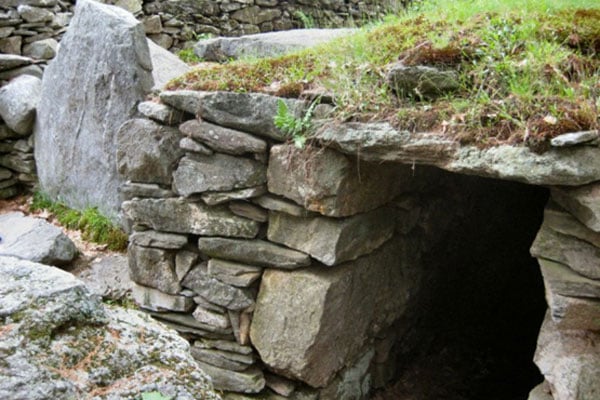
The site, in North Salem, N.H., includes stone monoliths and chambers spread across 30 acres. The stones are said to have complex astronomical alignments. A 4.5-ton stone slab that seems to be the focal point of the site may have served as an altar for sacrifice. It is grooved with a channel for draining, possibly the blood of a victim. A variety of characteristics have fueled a theory that America’s Stonehenge was built by Europeans as long ago as 2,000 B.C.
She also claims:
http://www.ancient-origins.net/anci...y-be-4000-years-old-did-celts-build-it-001668It seems from astronomical alignment that the megaliths mark cross-quarter holidays.
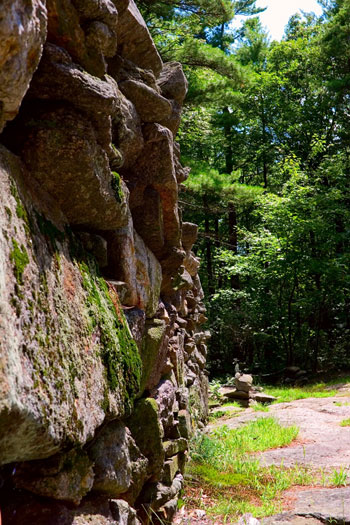
[Megalithic structure at Mystery Hill]
Archaeologists have found Native American artifacts on site that are more than 1,000 years old. The use of stone-on-stone tools shows workmanship similar to that employed by Native Americans.
I have to say though that the megalithic wall in the photo above is quite impressive. It makes me think it was built with more than just the effort of a few colonial farmers.
She showed some more photos and adds:
The big problem with the last paragraph is that we don't know that the builders were lining up these rocks to certain stars, and if so, then to which ones and when? So if a star aligns with a rock in 1500 BC, how do we know that this means the rock was intended to have that alignment or even put in place then?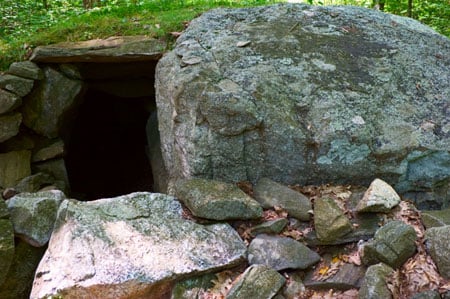
In 1969, archaeologist James Whittall unearthed stone tools at the site, along with charcoal flakes that could be carbon dated. The dating showed the tools’ user was working around 1,000 B.C., according to Goudsward and Stone.
Whittall recovered charcoal from several other locations on site and carbon dating ranged from 2,000 B.C. to 400 B.C.
Dating Using Astronomical Alignments
Astrological alignments concur. Astronomer Dr. Louis Winkler, the principal site scientist, found the positions of some stones align with where the stars and other celestial objects would have been about 2,000 years ago. He has also done radiocarbon and laser theodolite dating to support a Bronze Age origin (2,000 B.C.–1,500 B.C.).
http://www.ancient-origins.net/anci...y-be-4000-years-old-did-celts-build-it-001668
Jim Vieria shows a picture of the Royalton, VT mound in his essay "Search for the Mysterious Stone Builders of New England", mentioning sites in other regions:
http://www.barbaradelong.com/specia...e-mysterious-stone-builders-of-new-england-2/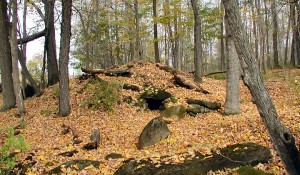
Scattered throughout the woods and fields of New England lie the remains of an ancient civilization. These remnants are enigmatic stone structures that predate European settlement. Standing stone circles, hundreds of impressive and elaborate stone chambers, massive balanced stones, over one million stone cairns, stone animal effigies, solstice and equinox markers and many other unexplained structures litter the landscape. Historical texts, colonial reports, carbon dating, astro-archeological research and Native American oral traditions all support this contention.
The Adena, Hopewell and Mississippian mound building cultures built earthen mounds, pyramids and geometric enclosures that showed an extremely high degree of engineering and mathematical skill. Shell and midden mounds were built from Florida to Maine.
He talks about "elaborate cairns, sometimes up to 9 feet high and conical" and "the 25 foot high 200 foot long, Hopkinton, MA cairn", before talking about Mystery Hill:
http://www.barbaradelong.com/specia...he-mysterious-stone-builders-of-new-england-2this 30 acre complex is a mixture of stone chambers, stone solstice and equinox markers, cairns, chimneys, fireplaces and stone drains. The two largest stones here weigh 45 and 70 tons. The site has been carbon dated to at least 2000 B.C. by scientists at Geochron Labs of Cambridge, Mass after dating 13 different test pits. ... Stone markers throughout the site provide over 200 alignments with the sun, moon and 45 different stars which have been verified by independent researchers. One alignment wall allows a person to observe the southern most standstill of the moon on its 18.61 year metonic cycle.
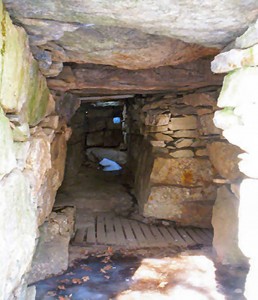
Like I said, it is hard for me to judge the charcoal carbon dating's full value, since after all, making charcoal in the fire in 2000 BC is not the same thing as putting up the wall.
[SIZE=-1]
Next Vieria writes about Gungywamp, a site in Connecticut:
[/SIZE]
[SIZE=-1][SIZE=-1]In a letter dated November 30, 1654 by John Pynchon (founder of Springfield, Mass.) lends strong support to the idea that many stone structures existed here before the colonists arrived. “...Sir, I hear a report of a stonewall and strong fort (chamber) within it, made all of stone, which is newly discovered at or near Pequet (presently known as the Gungywamp Range), I should be glad to know the truth of it from your self, here being many strange reports about it”.
...
[/SIZE]The complex has stone chambers, precolonial walls, a bird petroglyph, a double concentric ring of 21 large quarried stones and has been carbon dated to 600 A.D. Nearby there are several large standing stones that have been carefully positioned along astronomical site lines. The main chamber has a stone lined shaft that was designed precisely to permit theEquinoctial sunset to fully penetrate the chambers dark interior only on the spring equinox. The high density of the granite in the stones magnifies the intensity of the sunlight entering the chamber.
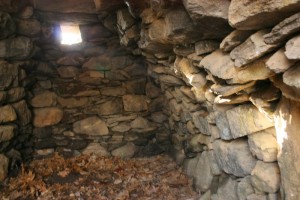
http://www.barbaradelong.com/specia...e-mysterious-stone-builders-of-new-england-2/
What do you think?
[/SIZE]












